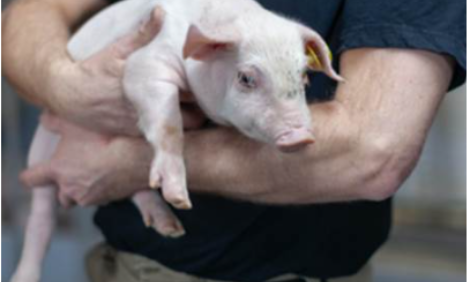



Estimated Carbon Footprint of Pork Production in the US
Dr Lee J. Johnston of the University of Minnesota Swine Extension explains how the life cycle assessment for pork production from 'sow to plate' is evolving and being refined.
"About two years ago, my Pork Professor column was titled 'What is the carbon footprint of your pork?'" writes Dr Johnston. "The objective of that column was to get folks thinking about how their pork production system affects the environment through generation of greenhouse gases (GHG) which are believed to contribute to global warming." At that time, the whole issue of pork production's carbon footprint was pretty fuzzy, he continues, but he predicted there would be more clarity in the coming years.
Recently, at the University of Minnesota's Allen D. Leman Swine Conference, Drs Greg Thoma and Ralph Martin from the University of Arkansas added some clarity to this issue when they presented their estimate of the carbon footprint of pork. Their work was funded by the National Pork Board.
In their estimate, the researchers used a life cycle assessment (LCA) approach to estimate the GHG production from 'cradle to grave' for a four-ounce boneless serving of pork eaten by a consumer. Recall that the GHG of greatest interest related to animal agriculture are carbon dioxide (CO2), methane and nitrous oxide. Carbon dioxide has the least potential to contribute to global warming while methane is 21 and nitrous oxide is 310 times more efficient at trapping heat in the atmosphere thus contributing to global warming. To assess the overall contribution of these three GHG, all GHG are reported as CO2 equivalents. So, a given quantity of nitrous oxide would contribute 310 more CO2 equivalents than the same quantity of carbon dioxide.
The LCA approach used in their study accounted for GHG emissions that result directly from raising pigs in addition to those emissions resulting from related activities that support pig production. The production system studied for this estimate included GHG emissions from: crop production which included such things as fertiliser manufacturing, gasoline and diesel use, crop transport, and electricity; on-farm manure management practices; transport of pigs from farm to harvest and processing plants; pork processing and packaging; transport of product to retail sites; retail storage and display; consumer transport of product to their homes and cooking of the product; and disposal of packaging by the consumer.
* "Production of pigs generates the largest portion of GHG emissions – 75 per cent of the total" |
The estimate of GHG production is based on an 'average' production system in the US. This average production system was based on the productive life of one sow assuming she produced 3.5 litters of 9.5 pigs for a total of 30 finished pigs marketed at 268 pounds live weight each. The model assumed that pigs were fed corn-soybean meal based diets that included some DDGS, and were housed in confinement facilities that included a farrow-to-wean unit and a wean-to-finish unit. Manure management included under-barn, deep pits or anaerobic storage. The cumulative GHG emissions from all the inputs required to produce these pigs, process the pigs into retail four-ounce portions of boneless pork, and prepare those portions for home consumption were divided by the total weight of finished animals produced by the model sow. The estimates of GHG emissions do not represent a specific production system but rather an overall average of US production, processing, and distribution systems.
The estimated overall average carbon footprint for production, preparation, and consumption of one four-ounce portion of boneless pork was 2.2lb of CO2 equivalents. Due to the uncertainty around this type of estimate, it is nearly impossible to establish a single number as the correct answer. So, the 95 per cent confidence band ranges from 1.8 to 2.7lb CO2 equivalents per four-ounce portion of boneless pork. This confidence band says that there is a 95 per cent certainty that the correct answer is between 1.8 and 2.7lb CO2 equivalents. This estimate of 2.2lb CO2 equivalents is the accumulation of several stages in the production cycle.
The contribution from each stage to the total was estimated to be: 12 per cent from the sow (including feed and manure handling), 60 per cent from raising the pigs (nursery to finish including feed and manure handling), 5.3 per cent from processing and packaging, 9.4 per cent from retail (electricity and refrigerants) and 3.3 per cent from the consumer of the boneless pork.
This study demonstrates that production of pigs generates the largest portion of GHG emissions (75 per cent of the total) resulting from the consumption of pork. However, it is interesting to note that other stages of the food chain account for 15 per cent of the total and can influence the carbon footprint of pork products.
It is apparent that the science of GHG emissions has progressed in the last two years and will continue to improve. Future estimates will be more accurate and will likely look at individual production systems and practices. Once scientists can focus in on GHG emissions of specific aspects of a production system, interventions can be developed and tested to discover approaches to decrease the GHG emissions generated in the production of retail pork products. Stay tuned.
December 2010








